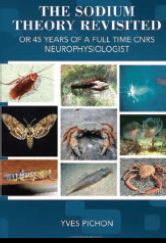
Physiology News Magazine
Book review
The Sodium Theory Revisited (or 45 years as a full time CNRS neurophysiologist) By Yves Pichon
Membership
Book review
The Sodium Theory Revisited (or 45 years as a full time CNRS neurophysiologist) By Yves Pichon
Membership
David Miller
https://doi.org/10.36866/pn.92.51

This is at once an unusual and a strange book. First, it is an example of ‘vanity publishing’, a rarity in research science. ‘Vanity’ must seem pejorative, but with the Internet blog as surely the ultimate vanity publishing vehicle not without its merits, this alone is no condemnation. Indeed, for many years there has been a paucity of monographs in our field where distinguished authors describe their ideas, report unpublished work and offer detailed ruminations on their research. The book’s title is pregnant with the promise of a consideration of ‘the sodium theory’ (of nerve excitability) in such a context. Sad to report, Pichon’s effort is a bitter disappointment.
Yves Pichon has had a long career in basic neurophysiological research, working almost entirely on invertebrate species. He has collaborated with distinguished neurophysiologists such as Hans Meves, Joan Abbott, John Treherne and many others. As his subtitle confirms, he was a career scientist with the principal French research agency, the Centre National de la Recherche Scientifique (CNRS).
So, is this brief book (fewer than 100 pages in A5 format and dominated by graphs and experimental traces rather than text) a distillate of Pichon’s work and science? Well, no. We are offered a series of (often very brief) ‘chapters’ with promising titles such as: ‘The insect Blood-Brain Barrier’, ‘Osmotic Stress’, ‘Axonal Membrane Channel Noise’. But these ‘chapters’ generally contain just a few introductory sentences, sometimes a little methodological detail, one or two results plots … and that’s it. It is salutary to note that all the figures (with graphical styles that vary throughout the book) are unattributed. At first glance, one might think these are from the previously unpublished, and thus potentially the more fascinating, ‘bottom drawer’ findings of a life-long researcher. But, as I too easily established, many (perhaps all?) have indeed already been published. Since there is no acknowledgement for the re-use of these illustrations, I fear the author could have overstepped publishing conventions, at the very least.
But, the niceties of copyright apart, what is spectacularly lacking is any coherent narrative to explain what is being presented to the reader. The promise in the book’s title turns out to be entirely empty. The foreword could well be the book’s scene-setter, but it is superficial as well as being garbled. (Distressingly, Pichon muddles the temporal relationship of Hodgkin’s 1956 [sic] Croonian Lecture to the Royal Society – actually delivered in 1957 and published in 1958 – with Hodgkin’s receipt of the Nobel Prize [in 1963]. Yet, two pages later, he has the chronology of all this correct, albeit offering little else of import in the barely 300 words that comprise “Chapter One”.)
Readers already steeped in the field to which Pichon has valuably contributed might find this random-seeming collection of figures and experiments of interest. But the general physiological reader will find very little to illuminate, divert or reward their attention. As I remarked at the start, this is indeed a strange and unusual book, but ultimately entirely a disappointment.
Would you like to submit a book review to Physiology News? Please get in touch with us on magazine@physoc.org
